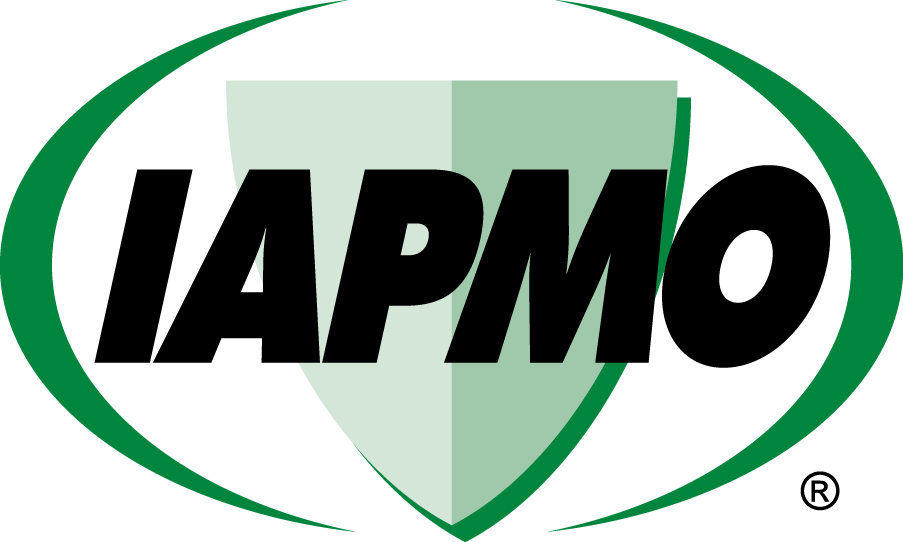
Photo courtesy of Pexels; Kehn Hermano
Detecting water leaks in buildings before they become a serious problem can protect building owners and occupants against significant damage and expense.
All commercial buildings require water for a variety of purposes, both for use by people and by equipment. The plumbing system that brings that water into the buildings (and drains it back out) is engineered and designed to be efficient and durable, with the expectation of providing many years of trouble-free service. However, those plumbing systems have many parts and pieces that are installed or maintained by many different people with multiple factors that can affect the integrity of any aspect of the plumbing system. Sometimes, the installation is faulty, but not discovered until sometime later. Other times, lines are abandoned in place or the maintenance is lacking. Still other times, external factors come into play, such as unexpected weather, building damage, or changes in use. Any of these conditions can cause a weakening or failure of the plumbing system that can cause a water leak and potential harm to people and damage to property. This course looks at the problem of water leaks and the related water damage issues. It then reviews some of the traditional means to safeguard against these issues by using a leak detection system. In particular, the latest technology of using a wireless leak detection system is explored and compared to other systems to help design professionals make decisions on specifying the most appropriate system for commercial buildings.
THE PROBLEM: WATER LEAKAGE POTENTIAL
All commercial and mixed-use buildings have the need for water to be provided and drained away. According to the U.S. Environmental Protection Agency (EPA), water is typically used for the following multiple purposes in commercial buildings:
- Restrooms/drinking – an average of 37 percent of total use
- Cooling and heating – an average of 28 percent of total use
- Landscape watering – an average of 22 percent of total use
- Kitchen/dishwashing – an average of 13 percent of total use
Any of these uses carry the potential for being the source of a water supply line leak or for a drain to become plugged and overflow.
Sometimes it is the buildings themselves that carry increased risk for leaks including any of the following:
- Newly constructed buildings that need to go through a start-up and commissioning period to find and detect any issues
- Aging buildings/buildings more than 20 years old
- Buildings with raised floors which can conceal inconsistencies in the plumbing
- Buildings that experience extreme seasonal weather, causing expansion and contraction of the piping system
- Medical related buildings with extensive plumbing/piping systems located near sensitive and expensive equipment or near the storage of irreplaceable medical samples
- Multi-floor buildings with tenants above and below each other with multiple sources of water on each floor
Design professionals engaged in any of these higher risk types of buildings should certainly pay careful attention to the potential for water leakage from the plumbing and drainage systems and the means to address it.
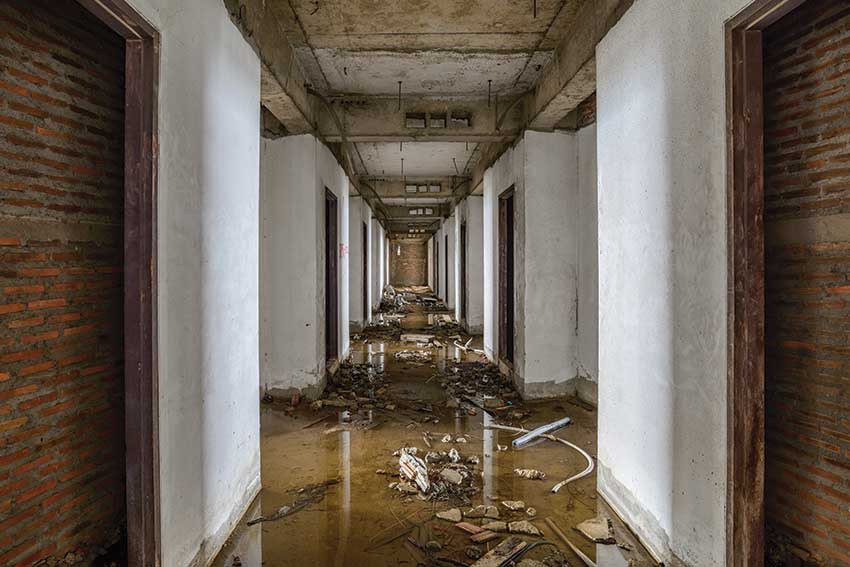
Photo courtesy of WATTS Water Technologies
An undetected water leak can cause considerable damage to a building, interrupt building operations, and create potentially unsafe indoor environments for occupants.
THE BUILDING ISSUE: WATER DAMAGE
According to the insurance industry, water damage is the number one cause of property loss claims in commercial buildings by a significant margin. The average commercial building insurance claim for water leakage is on the order of $80,000 to $90,000. The size of the building certainly matters, too, with some companies estimating an average leak to cost $25,000 per affected floor. Nationwide, claims for water leaks represent a $10 billion a year problem that is on the order of 71 percent of the total value of claims made, leaving only 29 percent paid out for all other claims.
Beyond the dollar amount, the frequency of water damage events is significant. The number of individual water damage claims are more common than fire and theft combined. On average, 57 percent of all real estate insurance claims made are for water damage, leaving only 43 percent for everything else.
The bigger picture reality is that water leaks happen all the time and in almost every building. In multi-story buildings in particular, water will flow down, meaning leaks that occur in upper levels can affect multiple floors below it. Buildings with reduced occupancy are also at a high risk, as there are fewer people and reduced maintenance staff to notice and find leaks.
The damage caused by water leaks is not only to the building or its contents, but also to the people who occupy the building. In certain situations, water leaks cause mold to grow inside the building, which can directly impact human health. This human health concern can multiply the cost of insurance claims dramatically and, in many cases, may not be covered.
Ignoring the issue of water damage from leaks can become a significant problem for building owners and a serious risk management issue for design professionals, too. At the very least, business or other operations may be disrupted in parts or all of the building. People who occupy a building with undetected water leaks may see their health and general welfare suffer. From a sustainability standpoint, ongoing water leaks are clearly counter to green building and sustainability practices that focus on water conservation and managed use. If an undetected leak goes on for any significant amount of time, then the longer it takes to discover and repair that leak, the bigger the clean-up and the higher the costs will all likely be.
Some examples of typical water leaks affecting people and buildings include the following:
- A corroded pipe on a hot water tank relief valve went undetected in an office for an entire weekend. The damage extended to nine floors and resulted in losses of $600,000.
- During a high-rise renovation, an abandoned water line ended up slowly leaking for an extended amount of time. Unbeknownst to the contractor, pressure began building up in the pipe, causing the water column to rise as high as four levels before finally breaking through the plaster. Losses mounted to more than $500,000.
- A window inadvertently left open in a vacated tenant space caused a pipe to freeze just inside the exterior wall. Coupled with the heat shut off during the vacancy, the pipe burst, and water leaked down four floors. This oversight resulted in a $100,000 loss.
Clearly, water leakage in buildings is an issue that cannot be ignored.
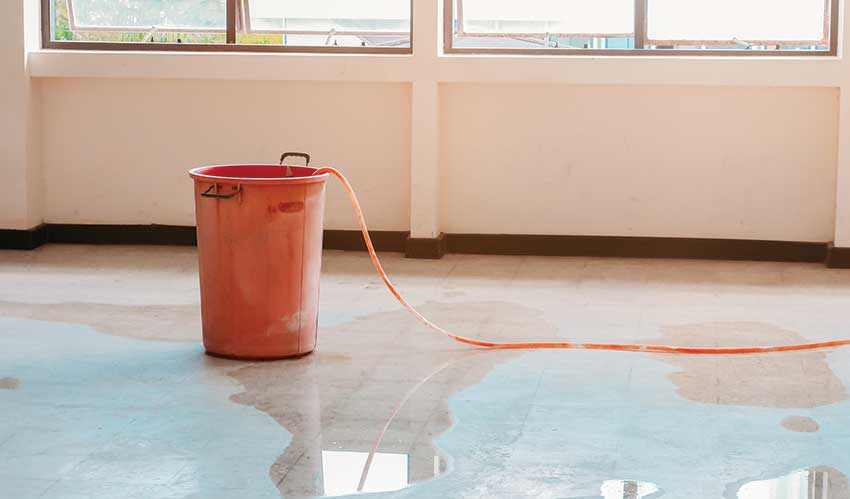
Photo courtesy of WATTS Water Technologies
Cable sensors are sometimes used for large areas or for hard to reach locations, but they can be much more expensive than wireless systems since they require electrical power to multiple locations.
TRADITIONAL LEAK DETECTION SOLUTIONS
If a water leak occurs in a building, then someone needs to know about it quickly so it can be repaired. Simple visual or auditory observation by users or maintenance staff in commercial buildings is the most basic, but obviously the most unreliable, method. That is because leaks can happen even when the building isn’t occupied or when maintenance staff are off duty. Even if the building is occupied, people may not be near the location where the leak occurs (mechanical rooms, etc.). If the leak is seen, then some people may not recognize it as a problem, assuming that it is a normal maintenance or cleaning activity.
Stand Alone Water Sensors
A better method over simple observation is to have a device available that triggers an audible alarm if a leak occurs, much like a smoke alarm alerts people to that hazard. Water alarms, sometimes called “screamers,” are inexpensive point sensors that are placed on the floor – if they detect water, then they sound an alarm or “scream.” This is technology from the 1980s that are stand-alone devices – i.e., they are not connected either to each other or to any other monitoring system. They are obviously only effective if someone is within earshot to hear it, understands what it is for, and can act on it. Hence, these qualities make them suitable for single family residential use, but not as well suited for commercial use.
Sensing Cables
A more common commercial building solution is to use a long-line sensing cable that can sense water at any point along the wire or an attached sensor. This approach requires electrical power to each wire or sensor, so that needs to be planned and designed for accordingly. While the cables can cover a large area, if there is limited power, then additional electrical wiring is needed which can be costly. Therefore, they are most commonly used in computer server rooms and data centers where lots of power and wiring are already available and there is a need for extensive water leak detection. Sensing cables can also be good for placement in tight, hard to reach areas, although once installed, they may be difficult to maintain and access.
Flow Metering
Another choice to detect a potential leak uses a sensor on supply water piping to monitor the flow in the amount of supply water. The sensor is tracking for any unexpected increase in the amount of water flowing over time through the piping – a possible sign of a leak in the line somewhere. The goal is to sense water that is coming out of the pipe, not just flowing through the pipe. However, since it is only measuring water flow in a piping system, it does not locate where the leak is occurring. There are two types of flow sensing, also called flow metering. The first type is wrapped around an existing meter and is noninvasive, keeping the existing plumbing intact. The second type is installed as a submeter and interrupts the pipe for the meter installation.
In terms of effectiveness, detecting leaks in a commercial building is very difficult to do with flow metering technology alone. In many cases, there may only be a slow drip that needs to be found which wouldn’t be detected by most meters. In a typical 1.5-inch -diameter pipe, for example, the flow meter needs to be extremely sensitive to discern between 10 gallons per minute (gpm) and a potentially damaging 10.05 gpm.
Based on the above, flow metering makes the most sense for small areas where identifying a few sources of water flow is straightforward. It may also be helpful for buildings that do not have 24-hour security personnel to respond to a leak notification when accompanied by a main valve to shut off the water if an alarm occurs. In single-family homes, sensing flow is a good solution since there are only a few water sources, such as where people are showering or cooking. But for commercial buildings, water can be flowing all the time through risers, domestic water lines, wastewater lines, HVAC water lines, etc. Hence, it’s very difficult to use flow meter sensing reliably in so many places, with so much water flow and so much variability.
WIRELESS LEAK DETECTION SYSTEMS
Given the limitations of the traditional leak detection systems, the most up-to-date option in commercial buildings is the use of a wireless, sensor-based system. Wireless systems can be installed and operate anywhere that a wired system can, just for less cost since there is no wiring needed. They can also be installed in many places where wired systems are not practical. These systems use cloud based IoT (Internet of Things) technology often combined with Radio Frequency (RF) network systems in the building. Just like a smoke or fire detection system, these wireless systems act automatically to sense for water leaks. An internet cloud platform is available that provides remote monitoring anywhere in a building 24/7 and informs building staff when and where leaks are occurring before they become a flood. If needed, electronically controlled shut-off valves can also be added to the design to shut off water flow automatically. Valves can be programmed to close upon the alarm from one or many sensors in a given area or floor.
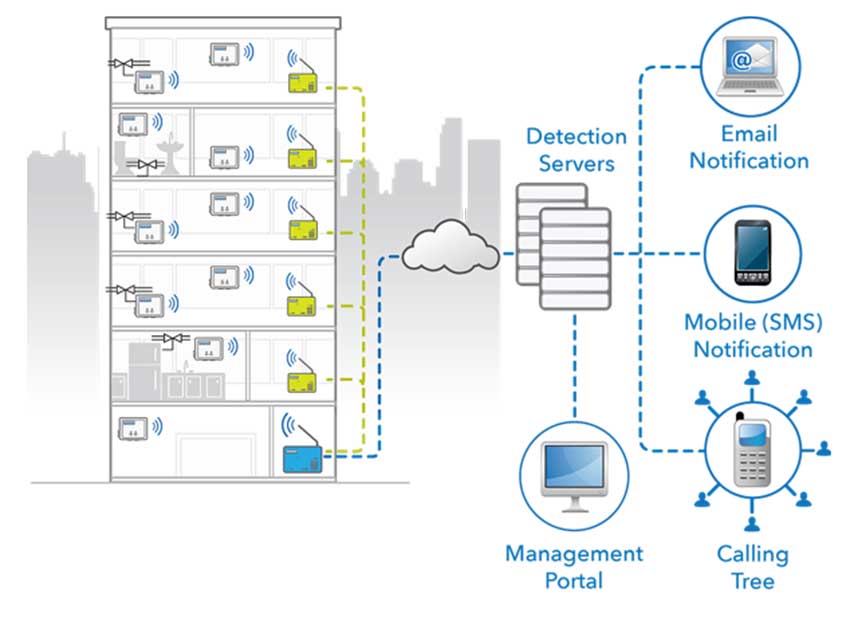
Photo courtesy of WATTS Water Technologies
A fully coordinated wireless leak detection system uses a tightly managed system to detect and communicate water leak alarms and alerts.
Some of the specific attributes of wireless leak detection systems are discussed in the following sections.
Quality Standards
Factory Mutual (FM) is one of the largest global commercial insurance carriers known for providing clients with engineering solutions to reduce risk. They operate an Approvals Certification program for manufacturers to have their products independently tested for use in buildings. FM Standard 7745, “Approval Standard for Liquid Leak Detectors” establishes the benchmarks for best-in-class certification for water leak detection equipment. When specifying or incorporating a wireless leak detection system, the label “FM Approved” indicates that a system meets the stringent FM standard 7745 and receives the certification mark.
How It Works
A wireless leak detection system fundamentally involves battery powered leak detection sensors located throughout the building that are connected wirelessly to distributed hubs (typically every 1-2 floors). The hubs are then connected to a central building base station. Communication inside the building is routinely through radio frequency (RF), not Wi-Fi, because communication ranges are often required in the hundreds of feet. RF is in the sub-1000 MHz – the lower the frequency, the longer the effective distance.
The RF backbone of the system includes the strategically located base station, which communicates via RF to the required number of hubs located as needed throughout the building. The hubs in turn communicate wirelessly to potentially hundreds of endpoints located throughout their area of coverage. These endpoints can be sensors, electronic valve controllers and, most recently, flow meters.
The base station itself is plug powered and is the only piece of equipment connected to the Internet via Ethernet wiring or a cellular data connection. If preferred, the base station can connect to the cloud via cell modem or Wi-Fi. This connection allows facility management personnel to communicate remotely with the system to monitor its performance or receive alerts.
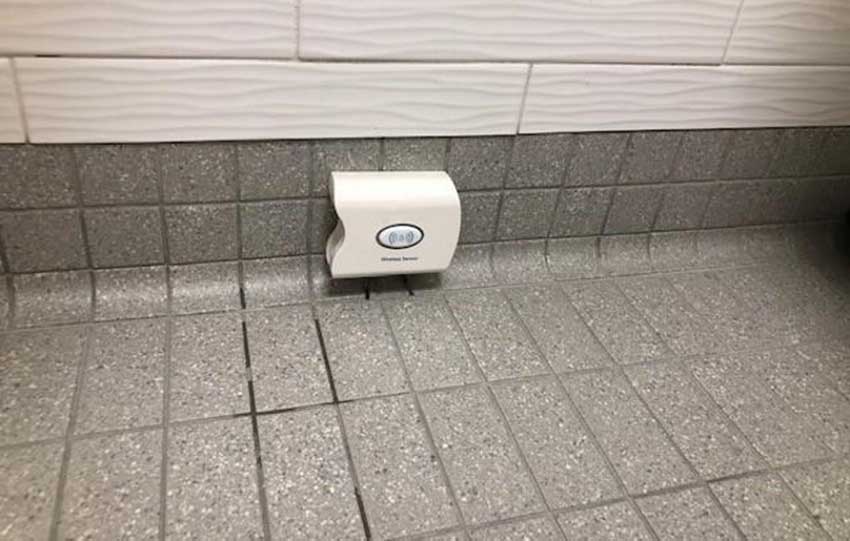
Photo courtesy of WATTS Water Technologies
Wireless water sensors that can be programmed to allow for a delay between the initial audible alarm and when messages are sent (in the event of a false alarm event) are more likely to be heeded when an actual alarm event occurs.
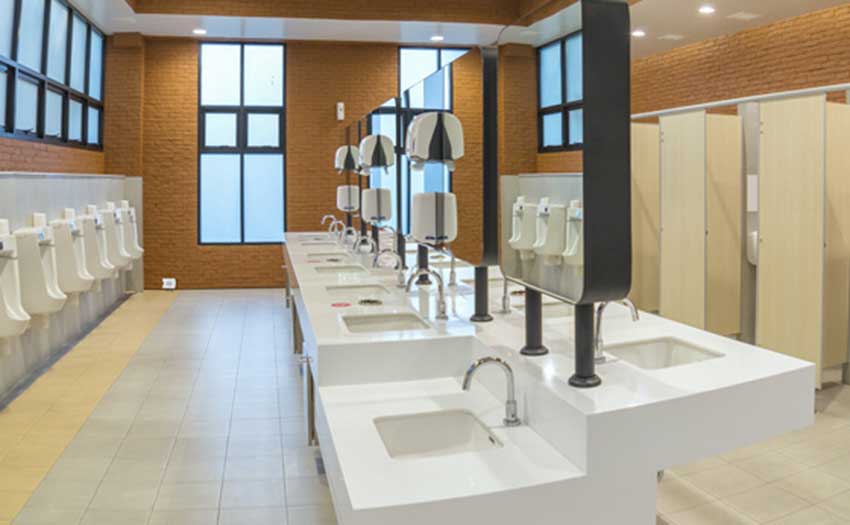
Photo courtesy of WATTS Water Technologies
A flexible, configurable system allows for changes, such as bathroom remodeling or upgrades or other direct changes to building plumbing systems.
Leak Detection Alarm
When any of the endpoints detect a leak or abnormality, an audible alarm is set off. At the same time, a wireless message is sent from the sensor to its closest hub, down the building to the base station, and out to the cloud. Three types of messaging then happen simultaneously to communicate the message that a leak is detected:
- Phone: A phone call is made, typically to the security desk, although the building owner or manager ultimately decides who receives calls.
- Email: E-mail messages are sent to preselected personnel.
- Text: SMS text messages are sent to preselected personnel.
This immediate notification system to multiple people in multiple ways helps to ensure that a leak can be responded to promptly.
Alarms Versus Alerts
It is worth noting that in addition to an alarm indicating that a leak has been detected, the system can also send alerts which are informational messages. Examples of alerts include a low battery in one of the endpoints or a loss of communication with a device for some reason.
If there is any concern about false alarms, it is good to know that they can be controlled. In many commercial buildings, a significant concern can be the ability to easily silence a sensor that is accidentally set off. For example, if the sensor is on the floor of a kitchen or restroom, janitorial staff can unintentionally cause the alarm to go off by hitting it with a mop or spreading cleaning water on the floor. In cases like this, having a delay is important, but the event should be recorded for tracking purposes. If it happens too often, the sensor should be moved to a different location. The delay period on the sensors should be configurable, because while a 15-second delay may be appropriate for sensors in the restroom, no delay should be used for sensors in an electrical room or other critical areas.
Flexibility Based on Modular Design
All buildings have the need to change over time, particularly as their operations, use, or occupants change. Therefore, any system in a building needs to be able to change easily and readily with it. Accordingly, wireless water leak detection systems have been designed to be easy and inexpensive not only to install initially, but also to modify over time, in any size or age of building. A look at some of the common things to consider when doing modifications follows.
- Adding sensors is the most common need such as when new plumbing is added or modified. Flexibility in this case relies on the ability to install additional sensors without the need for an electrician – in other words, increase the area being monitored without requiring additional electrical power. For simplicity and best practices, look for a system that automatically registers with the nearest hub device when it is activated. Also, consider the number of sensors that a total system can support before requiring additional communication equipment. In general, a good system can handle about 400 sensors per base station.
- If sensing cables are used as part of the system, then look for sensing cables that work seamlessly with the existing endpoints. There are other considerations for sensing cables, too, such as whether or not they are suitable for applications that include walls in chase areas, subfloors, plenums, drain pans, and around pumps, appliances, and HVAC equipment. Since the dimensions will matter, look for sensing cables that are available in multiple lengths and can support “daisy chain” installations from a central point. Durability is important here, so rugged materials, such as HDPE polymer that can provide corrosion resistance and hold up over the long term, are important. Relatedly, the mating connectors for sections of cables should be water resistant to prevent inaccurate readings. Finally, the cables should be easy to install and/or reinstall in order to be fully reusable after any leak events.
- Electronic valve controllers can be included as part of a new or existing system with the ability to stop the flow of water to one or more valves – both by automatic operation and by a manual control. The manual operation will require that a person first inspects the valve before it is reset to be sure all leaks are contained and repaired. The automatic/electronic operation provides multiple benefits to the building owner or operator—the most significant of which is the short time from when a leak is first detected to when the valve is fully closed, and the leak stopped. Since the valve controller is one of the end points of the overall system, all activity is visible, easy to manage, and event tracking is provided via the system software. Notifications are also provided, just like any other alarm when it shuts off a valve. It is also possible to provide for a delay time to silence the sensor manually and keep the valve open if that is determined to be a need. As part of the larger system, there should be automatic, periodic cycling of all of the valves to ensure their continued functionality, and they should all be certified to be safe for use with potable water.
Selecting the most appropriate electronic valve controllers for specific locations involves consideration of several criteria. First, address the number of valves that a device can control or whether internal relays are involved. Some may also have the ability to serve a sensor itself or be connected to a sensing cable for extended reach. A purely practical concern will be the pipe sizes that the valve is installed on (e.g., diameters from 0.5 to 2 inches) that need to be addressed and supported. Ultimately, the focus is on the ability for the valve controllers to automatically shut off the flow of water when a leak is detected. While simple monitoring around the clock is sufficient for many situations, a shut-off valve may be warranted to protect entire buildings, critical areas without 24/7 security personnel, or when the presence of water would create a safety hazard (as in a switchgear room).
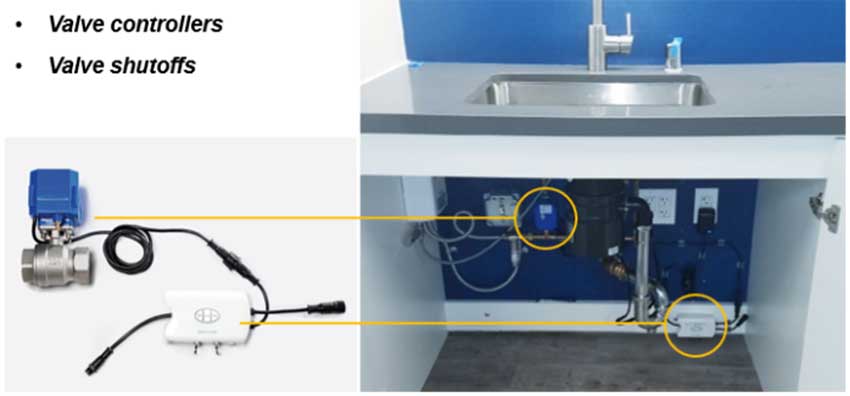
Photo courtesy of WATTS Water Technologies
Electronically controlled valve controllers and valve shut-offs are an integral part of a complete, effective, wireless water leak detection system.
Software Platform
Most wireless leak detection systems require some included software to control, access, and communicate data related to the system. When specifying a leak detection system, there are several attributes to look for in that software, including the following:
- Configurability The software should be highly configurable to allow building engineers and other key personnel to access the system remotely from any internet-enabled device, using any browser. Intuitive graphic design should make it easy to set up and configure devices quickly.
- Customization The software should readily enable system monitoring and device management, but most importantly for customization of various settings for each device, such as a pre-alarm delay period, or number of sensors that must alarm before closing a valve. Notification groups should be able to be created to receive alerts and alarms with the ability to make changes to accommodate vacation schedules, new hires, role changes, etc.
- Security In order to control who can access the system, the software should not be based on an app that can be downloaded to a device but, rather, through a program that is accessible from a desktop, laptop, tablet, or cell phone. That way, only authorized people can be given access to the program.
- Monitoring Information The software should make it very easy for all of the users to interface with this information. A central dashboard should provide at-a-glance information about all installed devices in a building or a portfolio of buildings. Robust analytics and reporting should be available to generate custom reports for specific needs of the building owners and operators. For record-keeping and management purposes, the information generated in those reports should include alerts and alarms that occurred within the last 30 day, plus an audit trail of every incident since the system was first installed.
In general, the system software needs to be looked at and assessed with the same scrutiny as the hardware used for the system.
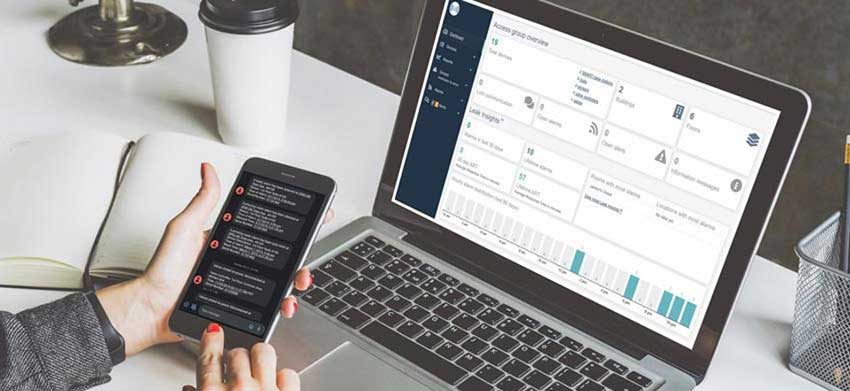
Photo courtesy of WATTS Water Technologies
The ability of the software to provide the needed information about leak detection in a building is critical to the successful and safe operation of the system.
Data Reporting
For each type of notification generated by the system, data is recorded and can be made immediately available. In particular, the precise time and location of a leak is reported, so the first person on the scene knows exactly where to go to turn off the alarm, resolve the issue, and reset the sensor. The system then keeps the data of when the leak happened, who received notifications, and how long it took someone to get there. Knowing this response time and sequence of events is an important feature for many businesses. Ultimately, all this data from leak events, alarms, and alerts can be stored, formatted, and used for reporting purposes. Overall, this helps create an information resource to contribute to better building management and to track the return on investment of the system.
Cybersecurity
Any electronic system that communicates with other devices or is connected to the internet is vulnerable to potential tampering or malicious activity. This potential threat is a big issue for everyone. Fortunately, a wireless leak detection system can address this concern in several ways.
The first thing to consider is that a wireless leak detection system should be on an isolated, stand-alone RF network, not on a Wi-Fi system as many residential systems might be. Next, none of the endpoint devices (sensors, valves, etc.) should communicate to anything other than its closest hub - they should NOT be communicating out anywhere else. The hubs then communicate only to the base station, which is the SINGLE point that goes out to the Internet for notifications. That one connection should be a wired (Ethernet) connection for better security. If Ethernet is not acceptable for a customer, cell communication is a great alternative because the cell system is separate from other local networks.
The overall system should be able to pass a security audit, ideally the strict audit requirements of a cyber-aware organization such as FM Global. That means the system should utilize the latest encryption and security features. Finally, as an added level of security, remote access can be disabled so no outside access is possible when security concerns arise.
System Resilience
Many building owners are increasingly concerned about the ability of all of the systems in their facilities to be able to withstand disruptions caused by severe weather, seismic events, or man-made threats. That includes the ability for critical systems to remain operational during such events to protect both people and property and help the building to quickly return to full functionality. Although water leak detection is not a life safety system like a fire alarm, there is still a need for a reliable back-up means to keep the communication and power going during interruptions. This might be even more important depending on the cause for the interruption.
Based on the above, incorporating a backup approach to a wireless leak detection system can be quite important in many situations. Accomplishing that requires attention to several key components. First, plug-powered devices need an internal battery back-up for redundancy, so the system continues to operate during a power outage. The internal battery back-up life expectancy should be at least four hours. Second, battery-operated devices should have a battery life expectancy of at least three years to allow for continued operation during outages. It is also important that “low battery” alerts are not only provided but followed up on by personnel to keep all batteries up to date. Third, it can be critical for the communication system to also have a back-up means to communicate - for example, an Ethernet failover to cell phone service. Finally, consider whether any of the components, particularly the base station, require a UPS (uninterruptible power supply) for the ultimate in outage protection. If such a UPS is already provided in the building for other reasons, it would be worthwhile to consider connecting the water leak detection system to it.
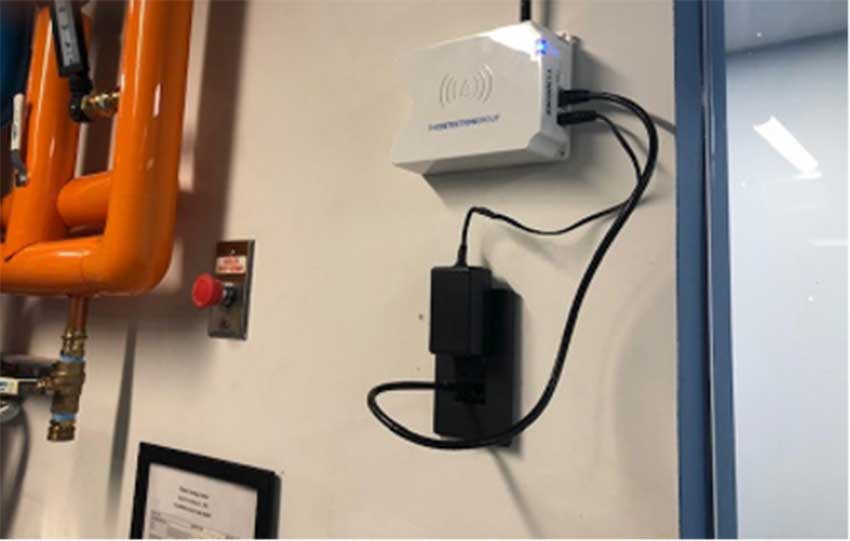
Photo courtesy of WATTS Water Technologies
The ability to provide a battery back-up to powered components, or a long-lasting battery in other components, can mean the difference between a truly resilient, reliable system and one that loses its ability to function when it may be needed most.
Cost Effectiveness
By now, it should be clear that building owners can save considerable money on damage and lost tenant income by detecting water leaks early enough to prevent damage. When looked at in this light, a wireless leak detection system that is always on, always sensing, and always ready to send real-time notifications can quickly provide for a positive return on investment (ROI) on the cost of the system.
An effective water leak detection and management response can also mean that insurance company damage losses will be reduced dramatically, ensuring loss ratios will be low and in line with stated risk management objectives. Minimizing water damage claims not only saves money for both carriers and for the insured, but it also critically allows continuation of insurance coverage at normal property rates versus increased rates that reflect losses from water damage.
To better illustrate the cost-effectiveness of leak detection systems, consider that, as previously noted, the average cost of a leak is $25,000 per floor. A wireless leak detection system can cost about $2,000 per floor, plus an additional $480 per year for software service. Hence, in a typical 10-story building, the installation cost is $2,000 per floor times 10 floors, which equals $20,000. Hence, the first-year cost is $20,480. If there is just one leak on just on one floor within the first year, the system will save the building owner $25,000, which more than pays for the system.
To further illustrate the cost implications of having a leak detection system compared to not having one, consider this real-life situation in a building in San Francisco. Three weeks after the installation of a wireless leak detection system in a 38-story office building, the building engineer reported that he received an alert at 5:30 p.m. on a Friday evening. The alert indicated that a toilet was overflowing in a 17th floor restroom which was not equipped with a floor drain. A member of the building maintenance staff was called in to quickly assess and correct the situation. The engineer believes if this action had not been taken, then the water would have migrated down the 17 floors all the way to the lobby before anyone discovered the overflow since the weekend had already started and the building was mostly unoccupied. By preventing just this one disaster, the system paid for itself many times over.
CONCLUSION
The problem and issues associated with water leaks in buildings are quite real and quite costly. A number of different types of water leak detection systems have been used over the years which provides insights into which types work best in different building types and situations. For commercial buildings, the most up-to-date, reliable, and cost-effective solution has been presented here as a wireless water leak detection system. Design professionals that incorporate such systems into new or existing commercial buildings can help overcome the problems of harm to people and damage to property while saving the building owners and managers considerable losses. At the same time, the well-being and safety of building occupants is improved.
Peter J. Arsenault, FAIA, NCARB, LEED AP is a nationally known architect and a prolific author advancing positive acoustical experiences through better building design. www.pjaarch.com, www.linkedin.com/in/pjaarch





